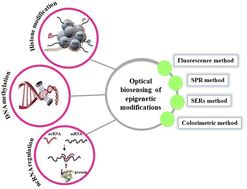Optical bio-sensing of DNA methylation analysis: an overview of recent progress and future prospects
Abstract
DNA methylation as one of the most important epigenetic modifications has a critical role in regulating gene expression and drug resistance in treating diseases such as cancer. Therefore, the detection of DNA methylation in the early stages of cancer plays an essential role in disease diagnosis. The majority of routine methods to detect DNA methylation are very tedious and costly. Therefore, designing easy and sensitive methods to detect DNA methylation directly and without the need for molecular methods is a hot topic issue in bioscience. Here we provide an overview on the optical biosensors (including fluorescence, FRET, SERs, colorimetric) that have been applied to detect the DNA methylation. In addition, various types of labeled and label-free reactions along with the application of molecular methods and optical biosensors have been surveyed. Also, the effect of nanomaterials on the sensitivity of detection methods is discussed. Furthermore, a comprehensive overview of the advantages and disadvantages of each method are provided. Finally, the use of microfluidic devices in the evaluation of DNA methylation and DNA damage analysis based on smartphone detection has been discussed.

- This article is part of the themed collection: 2022 Reviews in RSC Advances


 Please wait while we load your content...
Please wait while we load your content...